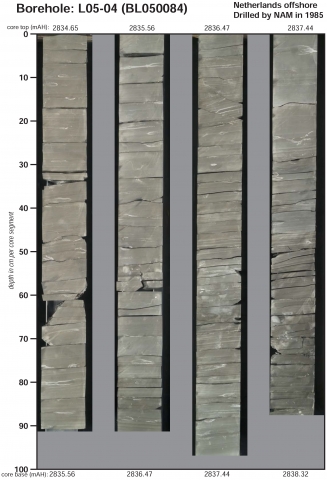Code
ATPO
Status
Formal (NAM & RGD 1980). Amended (Van Adrichem Boogaert & Kouwe 1994).
Lithological description
Dark-grey to brownish-black, bituminous, fissile claystone unit, which can be recognised on wire-line logs by its high gamma-ray and resistivity readings. The organic-rich unit is typically overlain by a distinct limestone unit, also occurring on sonic velocity profiles.
Depositional setting
Stagnant water conditions with pelagic deposition under anoxic conditions.
Definition of lower boundary
Conformably the non-bituminous, marine claystones of the Aalburg Formation.
Definition of upper boundary
If not truncated, overlain by the predominantly non-bituminous, marine silty claystones and siltstones of the Werkendam Formation.
Thickness indication
Up to 105 m.
Geographical distribution
Regional correlation
UK: Cerdic Formation; GER: Olschiefer Formation (Posidonienschiefer); BEL: -.
Age
early Toarcian.
Holostratotype
Well:
Depth (thickness) AH:
2205 - 2228 m (23 m)
Origin of name
Name derived from the German lithostratigraphy, where the lower Toarcian is called ‘Posidonienschiefer’. The unit was named after the dominant fossil type, a lamellibranch genus formerly called Posidonia (now Bositra).
Previous name(s)
None.
Reviewed by (date)
Sander Houben (2017).
References
NAM & RGD 1980. Stratigraphic nomenclature of The Netherlands. Verhandelingen van het Koninklijk Nederlands Geologisch Mijnbouwkundig Genootschap 32, 77 p.
Van Adrichem Boogaert, H.A. & Kouwe, W.F.P. 1994. Stratigraphic nomenclature of The Netherlands; revision and update by RGD and NOGEPA, Section F, Lower and Middle Jurassic. Mededelingen Rijks Geologische Dienst, 50, 1-20.
Cite as
TNO-GDN ([YEAR]). Posidonia Shale Formation. In: Stratigraphic Nomenclature of the Netherlands, TNO – Geological Survey of the Netherlands. Accessed on [DATE] from https://www.dinoloket.nl/en/stratigraphic-nomenclature/posidonia-shale-formation.
